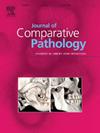Escherichia coli-associated granulomatous diseases in three cats
IF 0.8
4区 农林科学
Q4 PATHOLOGY
引用次数: 0
Abstract
Granulomatous diseases associated with Escherichia coli infection are uncommon in domestic animals. In cats, malakoplakia and granulomatous ulcerative colitis are the only described forms. We investigated the clinical and pathological findings of E. coli-associated granulomatous diseases in three cats. In all cases the affected organs were infiltrated by many macrophages containing periodic acid–Schiff-positive intracytoplasmic granules. The macrophages immunolabelled for ionized calcium-binding adapter molecule 1 and E. coli. The first case involved the urinary bladder and was diagnosed as malakoplakia. The second case had small intestinal granulomatous enteritis and lymphadenitis of the mesenteric, celiac, colonic, mandibular and mediastinal lymph nodes. The third case had granulomatous enteritis, splenitis and lymphadenitis of the mesenteric, iliac, aortic, renal, hypogastric and sacral lymph nodes. Peyer's patches were predominantly affected in the small intestines of both the second and third cases. Although malakoplakia has been documented previously, the findings in the second and third cases suggest novel forms of granulomatous disease associated with E. coli in cats, with notable primary involvement of lymphoid tissue.
三只猫的大肠杆菌相关肉芽肿病
与大肠杆菌感染相关的肉芽肿性疾病在家畜中并不常见。在猫,斑疹和肉芽肿性溃疡性结肠炎是唯一描述的形式。我们研究了三只猫大肠杆菌相关肉芽肿疾病的临床和病理表现。所有受累器官均被大量巨噬细胞浸润,巨噬细胞含有周期性酸-希夫阳性胞浆内颗粒。巨噬细胞免疫标记电离钙结合适配器分子1和大肠杆菌。第一个病例涉及膀胱,被诊断为斑疹。2例为小肠肉芽肿性肠炎及肠系膜、腹腔、结肠、下颌骨及纵隔淋巴结淋巴结炎。第三例为肉芽肿性肠炎、脾炎、肠系膜淋巴结、髂淋巴结、主动脉淋巴结、肾淋巴结、胃下淋巴结和骶淋巴结淋巴结炎。第2例和第3例患者的小肠主要受影响。虽然malakoplakia先前已被记录在案,但第二和第三例病例的发现表明,猫中与大肠杆菌相关的新型肉芽肿病,主要累及淋巴组织。
本文章由计算机程序翻译,如有差异,请以英文原文为准。
求助全文
约1分钟内获得全文
求助全文
来源期刊
CiteScore
1.60
自引率
0.00%
发文量
208
审稿时长
50 days
期刊介绍:
The Journal of Comparative Pathology is an International, English language, peer-reviewed journal which publishes full length articles, short papers and review articles of high scientific quality on all aspects of the pathology of the diseases of domesticated and other vertebrate animals.
Articles on human diseases are also included if they present features of special interest when viewed against the general background of vertebrate pathology.

 求助内容:
求助内容: 应助结果提醒方式:
应助结果提醒方式:


